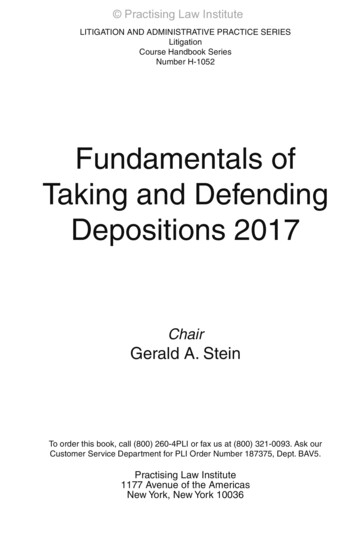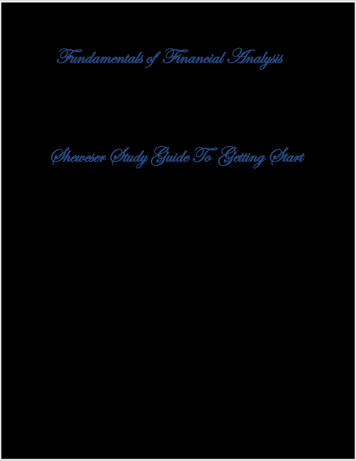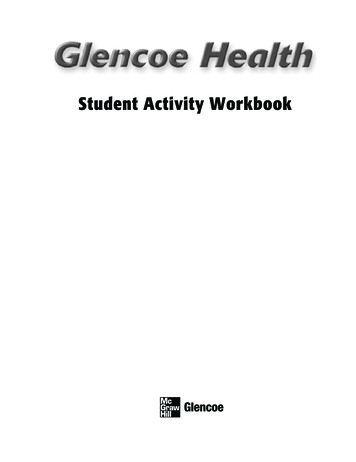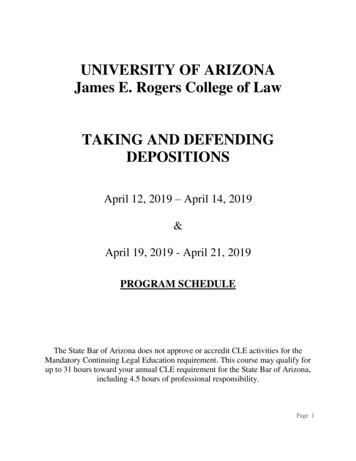
Transcription
Practising Law InstituteLITIGATION AND ADMINISTRATIVE PRACTICE SERIESLitigationCourse Handbook SeriesNumber H-1052Fundamentals ofTaking and DefendingDepositions 2017ChairGerald A. SteinTo order this book, call (800) 260-4PLI or fax us at (800) 321-0093. Ask ourCustomer Service Department for PLI Order Number 187375, Dept. BAV5.Practising Law Institute1177 Avenue of the AmericasNew York, New York 10036
Practising Law Institute1Overview of the Rules Governing Depositionsin Practice (Substantive Outline) (2016)Partha P. ChattorajAllegaert, Berger & VogelIf you find this article helpful, you can learn more about the subject by goingto www.pli.edu to view the on demand program or segment for which itwas written.37
Practising Law Institute38
Practising Law InstituteThis outline is intended to provide a broad overview of some of the rulesrelating to depositions in federal court. This outline is not exhaustive, butit is intended to be useful as a guide to your own research and practice.I.RULES GOVERNING DEPOSITIONSA.Rules governing depositions in federal courts may be located inseveral places, for example:B.1.Federal Rules of Civil Procedure2.Federal Rules of Evidence3.Judges’ Individual Practices4.Local Civil Rules for Federal District Courts (e.g., Local Rulesof the United States District Courts for the Southern andEastern Districts of New York) (“Local Civil Rules”)5.Statutes (e.g., 28 U.S.C. § 1782 (Assistance to Foreign andInternational Tribunals and to Litigants before Such Tribunals),28 U.S.C. § 1785 (Subpoenas in Multiparty, MultiforumActions)), 28 U.S.C. § 1821 (Witness Fees))6.New York or Other States’ Rules of Professional Conduct7.Case LawRules governing depositions in New York state courts may belocated in several places, for example:1.Civil Practice Law & Rules (“CPLR”)2.Judges’ Individual Practices3.Statements and Standing Orders of Administrative Judges4.Uniform Civil Rules for New York State Trial Courts (22NYCRR § 202 for Supreme Court)5.Commercial Division Rules of Practice (22 NYCRR § 202.70)6.Uniform Rules for the Conduct of Depositions (22 NYCRR§§ 221.1-221.3)7.Statutes (e.g., General Municipal Law §50-h for deposition ofpersonal injury claimants against municipalities)8.New York Rules of Professional Conduct9.Case Law339
Practising Law Institute10. Special rules regarding discovery, beyond the scope of thisoutline, exist for matrimonial, medical malpractice, real propertytax, and other actions.II.DEPOSITIONS UNDER THE FEDERAL RULESA.Depositions are one of the discovery methods permitted by thefederal rules. See Fed. R. Civ. P. 30(a).B.Depositions may be taken by stipulation, or on notice or by subpoena.See Fed. R. Civ. P. 29, 30(b), 45. No order of the court is necessaryto take a deposition, except in certain circumstances listed in Fed. R.Civ. P. 30(a)(2).C.Before an action is commenced or while an action is on appeal, adeposition may be obtained by court order to perpetuate testimonyor to aid in bringing an action. See Fed. R. Civ. P. 27.III.DEPOSITIONS GENERALLY UNDER NEW YORK STATE LAWA.Deposition is one of the disclosure devices authorized by the CPLR.See CPLR 3102(a). Practitioners who frequently appear in NewYork state court often refer to depositions as “EBTs,” which is shortfor “examinations before trial.”B.Deposition may be taken by stipulation, or on notice without leaveof the court. See CPLR 3102(b).C.Before an action is commenced, deposition (or other discovery) maybe obtained by court order to preserve information or aid in bringingan action. See CPLR 3102(c).IV.PRIORITY OF DEPOSITIONS IN NEW YORK STATE COURTA.Defendant normally has priority to take the first deposition. SeeCPLR 3106(a); Serio v. Rhulen, 29 A.D.3d 1195 (3d Dep’t 2006)(“As a general rule, in the absence of special circumstances,’ priority of examination belongs to the defendant if a notice therefor isserved within the time to answer; otherwise, priority belongs to theparty who first serves a notice of examination.”) (citations omitted).Practice Tip: If you represent a defendant, serve a notice of deposition with your answer to preserve deposition priority.440
Practising Law InstituteB.Plaintiff must obtain leave of court to serve a deposition notice beforedefendant’s time for serving a responsive pleading has expired.CPLR 3106(a). If plaintiff can show “special circumstances,” a reversal of priority may be warranted. Bennet v. Riverbay Corp., 40A.D.3d 319 (1st Dep’t 2007).C.Defendant may lose priority: “priority is deemed abandoned, however, where a party fails diligently to pursue disclosure.” Bucci v.Lydon, 116 A.D.2d 520 (1st Dep’t 1986).D.In practice, this issue is often addressed at a preliminary conferencewith the court, in which both priority and a timetable and schedulefor depositions are often determined. See 22 N.Y.C.R.R. § 202.13;Commercial Division Rule 11(c).V.TIMING AND NUMBER OF DEPOSITIONSUNDER FEDERAL RULESA.In federal court, pursuant to Fed. R. Civ. P. 26(d)(1), depositionsordinarily may not be taken until after the parties have conferred ingood faith about various matters, including the timing and scopeof discovery, see Fed. R. Civ. P. 26(f), and after the parties haveexchanged “initial disclosures,” which include the names and addressesof “each individual likely to have discoverable information – alongwith the subjects of that information – that the disclosing party mayuse to support its claims or defenses,” Fed. R. Civ. P. 26(a)(1).Certain types of proceedings are exempt from these requirements.See Fed. R. Civ. P. 26(a)(1)(B).B.The Rule 26(f) conference and Rule 26(a) initial disclosures mustordinarily take place before a scheduling conference is scheduledand a scheduling order, governing the course of discovery, is enteredby the district court under Fed. R. Civ. P. 16(b). See Fed. R. Civ. P.26(a)(1)(C), 26(f)(1).C.Unlike in New York state court, there is no “priority” in federalpractice. See, e.g., Nairobi Holdings Ltd v. Brown Bros. Harriman& Co., No. 02-CV-1230, 2005 WL 742617, at *3 (S.D.N.Y. Mar. 18,2005). In other words, the defendant is not presumptively entitled totake depositions first; either party may take depositions first, and noparty is required to delay taking discovery based on another party’sdiscovery requests. See Fed. R. Civ. P. 26(d)(3).541
Practising Law InstituteD.In federal court, leave of the court is required if the deposition wouldresult in more than 10 depositions being taken by one “side” of thelitigation (plaintiffs, defendants, or third-party defendants). See Fed.R. Civ. P. 30(a)(2)(A)(i). If there are multiple parties on one side,they are expected to confer and agree in advance on which depositions they collectively seek to take under the presumptive ten-deposition limit. See Advisory Committee Notes (1993 Amendment).VI.TIMING AND NUMBER OF DEPOSITIONS UNDER NEW YORKSTATE RULESA.In New York State Supreme Court generally, there is no limit on thenumber of depositions, other than as agreed by the parties or orderedby the Court.B.In the case of an action to recover damages for personal injury, injuryto property or wrongful death predicated solely on a cause or causesof action for negligence, a party is not permitted to serve interrogatories on and also conduct a deposition of the same party withoutleave of court. See CPLR 3130.C.In New York State Supreme Court generally, depositions are conducted “continuously and without unreasonable adjournment” fromday to day until complete. CPLR 3113(b).D.In the Commercial Division of New York State Supreme Court,however, depositions are limited to 10 in number per side, and eachdeposition is limited to 7 hours, as in federal court. See CommercialDivision Rule 11-d(a).VII. NOTICES OF DEPOSITION AND DEPOSITION SUBPOENAS INFEDERAL PRACTICEA.Only a party to litigation may be compelled to give testimony pursuant to a notice of deposition. See, e.g., United States v. AframLines (USA), Ltd., 159 F.R.D. 408, 413 (S.D.N.Y. 1994). This includesofficers, directors and “managing agents” of a corporate party orentity. See id.B.A subpoena is required to obtain the deposition of a non-party (includingemployees of corporate parties or entities who are not officers, directors, or managing agents), or, for overseas witnesses, the “HagueConvention on the Taking of Evidence Abroad in Civil or642
Practising Law InstituteCommercial Matters” or other procedures may have to be followed.See id.C.A non-party deposition subpoena is issued from the court in whichthe action is pending, see Fed. R. Civ. P. 45(a)(2), but in practice itcan be issued and signed by the attorney representing the takingparty, with caption designating the appropriate court, see Fed. R.Civ. P. 45(a)(3).D.The subpoena must also include the text of Fed. R. Civ. P. 45(d) and45(e), relating to duties and rights of non-parties responding to asubpoena. An official form of deposition subpoena, issued by theAdministrative Office of the United States Courts, in fillable PDFformat, is available online at n.E.When a deposition subpoena is served, a witness fee “for 1 day’sattendance and the mileage allowed by law” must be served with thesubpoena. See Fed. R. Civ. P. 45(b)(1). The witness fees and mileageare calculated pursuant to 28 U.S.C. § 1821. The witness fee forone day’s attendance is 40.00 (forty dollars). Mileage is calculatedfrom the witness’s residence to the place of deposition, and can bebased on either “common carrier” fares or automobile mileage, plustolls, parking fees, etc. See 28 U.S.C. § 1821.F.Generally, witness fees are paid by check from the serving party’slaw firm, payable to the witness, and served with the depositionsubpoena. Failure to include the check “can serve as an adequateground for the invalidation of a subpoena.” Carey v. Air Cargo Assocs.,No. M18-302, 2011 WL 446654, at *3 (S.D.N.Y. Feb. 7, 2011).Practice tip: Include with the subpoena a check for 40.00 plus agood-faith estimate of mileage fees in order to avoid problems.G.Copies of notices of deposition must be served on all parties; whena deposition subpoena is served, a notice of the subpoena must beserved on all other parties. See Fed. R. Civ. P. 30(b)(1).H.Service: A notice of deposition is served like other litigation papers,generally by service on the other parties’ attorneys. See Fed. R. Civ.P. 5. A deposition subpoena must be served “at any place within theUnited States” upon the named person pursuant to Fed. R. Civ. P.45(b)(2).I.Timing of Notice: The notice must be in writing and specify the timeand date of the deposition, providing “reasonable” advance notice to743
Practising Law Instituteall parties. Fed. R. Civ. P. 30(b)(1). A deposition subpoena may bequashed or modified by a court if it “fails to allow a reasonable timeto comply.” Fed. R. Civ. P. 45(d)(3)(A)(i).J.Place of Deposition: The notice or subpoena must state the place ofthe deposition, typically in an attorney’s office, but sometimes in acourthouse, a court reporter’s office or other locale.1.Plaintiffs: As a general rule, a plaintiff, having selected theforum in which the suit is brought, will be required to makehimself or herself available for examination there. See, e.g.,Estate of Gerasimenko v. Cape Wind Trading Co., 272 F.R.D.385, 387 (S.D.N.Y. 2011) (collecting cases).2.Defendants: As a general rule, defendants are required to bedeposed within 100 miles of their residence, employment, orregular transaction of business (or within the state of theirresidence, employment, or regular transaction of business, evenif the distance to the deposition is greater than 100 miles). SeeFed. R. Civ. P. 45(c)(1). There is a general presumption that adefendant’s deposition will be held in the district of his or herresidence. See, e.g., Six West Retail Acquisition, Inc. v. SonyTheatre Mgmt. Corp., 203 F.R.D. 98, 107 (S.D.N.Y. 2001).3.Non-Parties: Non-parties are required to be deposed within 100miles of their residence, employment, or regular transaction ofbusiness. See Fed. R. Civ. P. 45(c)(1).4.Attorney’s Fees for Distant Depositions: “When a depositionupon oral examination is to be taken at a place more than onehundred (100) miles from the courthouse, any party may requestthe Court to issue an order providing that prior to the examination, another party shall pay the expense (including a reasonable counsel fee) of the attendance of one attorney for eachother party at the place where the deposition is to be taken.”Local Civil Rule 30.1.5.These location requirements can be altered by stipulation or bycourt order, upon a showing of hardship or other circumstances.6.The Federal Rules expressly contemplate that a deposition canbe taken by telephone or other “remote means” by stipulationor by court order. See Fed. R. Civ. P. 30(b)(4). A motion of aparty to take the deposition of an adverse party be telephone or844
Practising Law Instituteother remote means will “presumptively” be granted underLocal Civil Rule 30.2.K.Duration of Deposition: In federal court, depositions are presumptively limited to “1 day of 7 hours,” unless otherwise stipulated orordered by the court. Fed. R. Civ. P. 30(d)(1). (This limitation doesnot appear in New York state court practice, other than in the Commercial Division of the Supreme Court.) The only time countedtoward this limit is “the time occupied by the actual deposition,” whichexcludes “reasonable breaks during the day for lunch and otherreasons.” Advisory Committee Notes (2000 Amendment).L.Production of Documents: The deposition subpoena or notice ofdeposition may require the production of documents or other thingsat the deposition. See Fed. R. Civ. P. 30(b)(2), 45(a)(1)(C).M.Recording Method: The notice of deposition must state the methodby which testimony will be recorded, see Fed. R. Civ. P. 30(b)(3)(A),as must a deposition subpoena, see Fed. R. Civ. P. 45(a)(1)(B). Typically the testimony will be transcribed by a court reporter (“stenographicmeans”), and it may also be recorded (“audio means”) or videotaped(“audiovisual means”).N.Objections: Objections to an error or irregularity in a depositionnotice is waived “unless promptly served in writing on the partygiving the notice.” Fed. R. Civ. P. 32(d)(1).VIII. NOTICE OF DEPOSITION AND DEPOSITION SUBPOENAS INNEW YORK STATE COURT PRACTICEA.Where the person to be deposed is not a party or an officer, directoror member of a party, you must serve a subpoena to obtain theirdeposition. See CPLR 3106(b). Otherwise a notice of deposition issufficient.B.Timing. A notice of deposition or deposition subpoena must be inwriting and provide at least 20 days’ notice to parties (CPLR 3107)and to non-parties (CPLR 3106(b)).C.Subpoenas. Article 23 of the CPLR governs subpoenas generally.See CPLR 2301 et seq.1.Subpoenas must be served in the same manner as a summons.CPLR 2303(a).945
Practising Law Institute2.D.As in federal practice, a witness fee must be paid to the witnessin advance. CPLR 2303(a).(a)The witness fee is governed by CPLR 8001, and is generally 18.00 for non-party deponents, plus 0.23/permile from place of service. No mileage fee is required ifthe witness must travel wholly within a city, under CPLR8001(a).(b)The witness cannot be compelled to attend unless the feeis paid in advance. Hampton v. Annall Mgmt Co., 168Misc. 2d 138 (App. Term 1st Dep’t 1996).3.Pursuant to CPLR 3101(a)(4), the subpoena must indicate “thecircumstances or reasons such disclosure is warranted.” Kooperv. Kooper, 74 A.D.3d 6 (2d Dep’t 2006). The amount of disclosure required by this rule varies between Appellate Divisiondepartments.4.If reasonable notice of an adjournment of the deposition isgiven to the witness, no further process is required to compelthe witness to attend on the adjourned date. See CPLR 2305(a).Practice tip: Include both your email address and phone numberon the subpoena and invite the non-party witness or theircounsel to contact you about scheduling.Place. The notice or subpoena must state the place of the deposition.Rules governing the location of the deposition in state court are asfollows:1.Parties must be deposed in the county where the party resides,has an office for the regular transaction of business or thecounty in which the action is pending. CPLR 3110(1).2.Non-Parties – If the non-party is a resident of New York, shemust be deposed in the county where she resides or works. Ifshe is not a resident of New York, she must be deposed in thecounty in which she was served, is employed or has an office.See CPLR 3110(2).3.Where the party is a public corporation (such as a city, town,school board, etc.), the deposition must take place in the countywhere the action is pending; however, it must be in the officeof the attorney representing the public corporation, unless theparties agree otherwise. See CPLR 3110(3).1046
Practising Law Institute4.All five counties (boroughs) of New York City are treated as asingle county for purposes of CPLR 3110.5.Where the application of the normal rules concerning locationwould impose “hardship,” the court may alter the location ofthe deposition. LaRusso v. Brookstone, Inc., 52 A.D.3d 576 (2dDep’t 2008).E.Production of documents or things. The notice of deposition orsubpoena may require the production of documents or other thingsat the deposition. See CPLR 2305, 3111. If the subpoena requiresproduction of documents or things by a non-party, the party issuingthe subpoena must defray the reasonable costs of production. SeeCPLR 3111.F.Special Considerations.1.Videotape. If you wish to videotape the deposition, you mustcomply with the Uniform Civil Rules for the Supreme Court,22 NYCRR § 202.15(c), which require that the notice state thedeposition will be videotaped, the name and address of thevideotape operator and the operator’s employer.2.Interpreter. The party taking a deposition must pay for the costsof an interpreter if the witness does not speak the Englishlanguage. See CPLR 3114.G.Errors in Notice. Errors in a notice of deposition are waived unlesswritten objection is served at least three days before the time fortaking the deposition. See CPLR 3112.IX.DEPONENTS THAT ARE ENTITIES (PARTY OR NON-PARTY)IN FEDERAL PRACTICEA.Entities: When the person to be deposed is an entity (e.g., a corporation, LLC, municipality, etc.), you do not have to designate inthe notice of deposition or subpoena the particular officer, director,member or employee of that entity that you wish to depose. Instead,you must “describe with reasonable particularity the matters forexamination,” and the named organization “must then designate oneof more officers, directors, or managing agents, or designate otherpersons who consent to testify on its behalf; and it may set out thematters on which each person designated will testify.” Fed. R. Civ.P. 30(b)(6).1147
Practising Law Institute1.The persons designated by the entity “must testify about information known or reasonably available to the organization.”Fed. R. Civ. P. 30(b)(6).2.The deposition of each individual designated by the entity pursuant to this rule is considered a separate deposition of 1 day of7 hours. See Advisory Committee Notes (2000 Amendment).3.“A subpoena must advise a nonparty organization of its duty tomake this designation.” Fed. R. Civ. P. 30(b)(6).4.Practice tip: Rule 30(b)(6) provides a powerful discovery toolbecause of the obligation of the receiving entity to identifyrelevant personnel and to investigate the designated subjectmatters to “educate” the designated testifying witness.B.Specific Individuals: “This paragraph (6) does not preclude a deposition by any other procedure allowed by these rules.” Fed. R. Civ.P. 30(b)(6). Thus, when the person to be deposed (either a party or anon-party) is an individual, including a particular officer, director,member, manager or employee of a party, you can simply designatethat person by name in the notice of deposition (if a party) or in thesubpoena (if a non-party).X.DEPONENTS THAT ARE ENTITIES (PARTY OR NON-PARTY) INNEW YORK STATE COURTA.Individuals. When the person to be deposed (either a party or a nonparty) is served with the notice or subpoena as an individual (forexample, if they are parties in their individual capacities, or percipient witnesses outside the scope of their employment), you simplydesignate that person by name in the notice of deposition (if a party)or in the subpoena (if a non-party).B.Entities. When the person served with the notice or subpoena is anentity (e.g., a corporation, LLC, municipality, etc.), and you wish todepose a specific individual within that entity, you may designate inthe notice of deposition (or subpoena) the particular officer, director,member or employee of that entity that you wish to depose. SeeCPLR 3106(d).1.The individual identified in the notice of deposition (or subpoena)must be produced, unless the entity notifies you in writing thatthat another person will be produced instead, and provides the1248
Practising Law Instituteidentity, description or title of that person, at least ten daysprior to the scheduled deposition. See CPLR 3106(d).2.If the person produced lacks sufficient knowledge of the factsat issue in the litigation, you can make a motion to compel thedeposition of the particular individual you wish to depose. Youwill be required to make a “detailed showing” of the necessityfor that deposition. See Colicchio v. City of New York, 181A.D.2d 528 (1st Dep’t 1992). You will need to explain in detailwhy the produced witness was inadequate. See Brown v. HomeDepot, 304 A.D.2d 699 (2d Dep’t 2003).C.Commercial Division. Under Commercial Division Rule 11-d(d),each deposition of an individual (even those employed by entities, ifsuch individuals are percipient fact witnesses) is treated as a separatedeposition for purposes of the durational and numerical limits ondepositions. Each deposition of an entity through a corporate representative is treated as a single deposition for purposes of thoselimits, “even though more than one person may be designated to testify on the entity’s behalf.” Rules 11-d(c), 11-d(e). These rules canbe altered by a stipulation of the parties or an order of the court. Id.XI.MOTION PRACTICE FOR DEPOSITIONS IN FEDERAL COURTA.Motion to Compel Compliance by Party: A motion to compelcompliance with a notice of deposition to a party is filed with thecourt in which the action is pending. Fed. R. Civ. P. 37(a)(2).B.Motion to Compel Compliance by Non-Party: Under Fed. R. Civ. P.37(a)(2), a motion to compel compliance by a non-party must befiled with the court for the district where the deposition is or willbe taken. Failure to obey the subpoena or an order related to it maybe punished as contempt of court. See Fed. R. Civ. P. 45(g).C.Timing of Motion to Compel: A motion to compel responses to specific questions can be filed after the deposition is otherwisecompleted, if necessary. Fed. R. Civ. P. 37(a)(3)(C).D.Protective Order: A motion for a protective order, or to limit orterminate a deposition taken pursuant to a notice of deposition, canbe filed with the court in which the action is pending or in the courtfor the district where the deposition will be or is being taken. Fed. R.Civ. P. 26(c)(1), 30(d)(3).1349
Practising Law InstituteE.Transfer of Motions: If the person subject to the subpoena consentsor the court finds “exceptional circumstances,” the court for thedistrict where the deposition is being taken may transfer a subpoenarelated motion to the district court where the subpoena was issued,i.e. the court where the subpoena was issued. Fed. R. Civ. P. 45(f).After the motion is decided, the issuing court may transfer the orderback to the district court where the deposition is to be taken, in orderto enforce the order. See id.XII. MOTION PRACTICE FOR DEPOSITIONS IN NEW YORKSTATE COURTA.Motion to Compel Compliance by Party: A motion to compelcompliance with a notice of deposition to a party may be filed withthe court in which the action is pending, CPLR 3124, or in the courtfor the county where the deposition is to be taken, CPLR 3125.B.Motion to Compel Compliance by Non-Party: Unlike in federalpractice, a motion to compel compliance by a non-party may be filedeither in the court where the action is pending or the county in NewYork State where the deposition is take place, at the option of themoving party. Failure to obey the subpoena or an order related to itmay be punished as contempt of court. See CPLR 2308, 3126.C.Protective Order: A motion for a protective order can be filed by thedeponent or any party with the court in which the action is pending,and service of such a motion suspends “disclosure of the particularmatter in dispute” (or, if necessary, the entire deposition) until themotion is resolved by the court. CPLR 3103.XIII. TAKING THE DEPOSITION UNDER FEDERAL RULESA.At the deposition, the officer before whom the deposition is conducted must put the deponent “under oath or affirmation” to tell thetruth. Fed. R. Civ. P. 30(c)(1).B.A deposition in the United States must be taken before “an officerauthorized to administer oaths either by federal law or by the law inthe place of examination,” see Fed. R. Civ. P. 28(a)(1)(A), before aperson appointed by the court where the action is pending, see Fed.R. Civ. P. 28(a)(1)(B), or before a person designated by stipulationof the parties, see Fed. R. Civ. P. 29(a).1450
Practising Law InstituteC.Procedures applicable to the officer before whom a deposition in aforeign country is taken are set forth in Fed. R. Civ. P. 28(b).D.A deposition must not be taken before a person who is any party’srelative, employee or attorney; who is related to or employed by anyparty’s attorney; or who is financially interested in the action. Fed.R. Civ. P. 28(c). Practice tip: Typically, the party noticing thedeposition pays a court reporting service for the services of a stenographer to record and transcribe the deposition, and that stenographeris usually also a notary public who administers the oath to thewitness.E.Objections based on disqualification of the officer before whom adeposition is taken or to be taken are waived if not made before thedeposition begins, or promptly after the basis for disqualification isknown or could have been known. Fed. R. Civ. P. 32(d)(2).F.Examination and cross-examination of the witness at the deposition“proceed as they would at trial under the Federal Rules of Evidence,”except with respect to rulings by the court under Fed. R. Evid. 103and exclusion of witnesses under Fed. R. Evid. 615. Fed. R. Civ. P. 30(c)(1).G.Because rulings by the court do not need to be made at the depositionitself, objections are “noted on the record, but the examination stillproceeds; the testimony is taken subject to any objection.” Fed. R.Civ. P. 30(c)(1). This includes any aspect of the deposition, includingthe qualifications of the officer before whom it is taken and themanner in which the deposition is taken.H.Objections to the competence of the witness, or to the competence,relevance or materiality of testimony, are not waived by failure tomake the objection before or during the deposition, unless the groundfor the objection might have been cured at the time of the objection.Fed. R. Civ. P. 32(d)(3)(A). Similarly, any objections to the form ofa question or answer, the manner of taking the deposition, the conduct of a party at the deposition, and other similar objections arewaived if not timely made during the deposition, if such mattersmight have been corrected at that time. Fed. R. Civ. P. 32(d)(3)(B).I.Most commonly, objections to the form of questions are waived ifnot made on the record at the deposition, because a timely objectioncould have permitted the questioning attorney to correct the question.By contrast, for example, objections to questions on the grounds ofrelevance or materiality can generally not be cured at the deposition,1551
Practising Law Instituteand are therefore not waived if not made at the deposition. In otherwords, such objections are preserved even if they are not made at thedeposition, and the objections can later be interposed if a partyattempts to utilize the evidence.J.Objections must be made concisely and in a non-argumentative andnon-suggestive manner (i.e. speaking objections are not permitted).Fed. R. Civ. P. 30(c)(2).K.A person may instruct a deponent not to answer a question only whennecessary to assert a privilege, to enforce a limitation ordered by thecourt, or to make a motion to terminate or limit the deposition. SeeFed. R. Civ. P. 30(c)(3).L.Under Local Civil Rule 30.3, “A person who is a party in the actionmay attend the deposition of a party or witness. A witness orpotential witness in the action may attend the deposition of a partyor witness unless otherwise ordered by the Court.” This local ruleclarifies the effect of the exception of Fed. R. Evid. 615 (witnessexclusion) in Fed. R. Civ. P. 30(c)(1).XIV. TAKING THE DEPOSITION UNDER NEW YORK STATE RULESA.Uniform Rules for the Conduct of Depositions. See 22 NYCRR§§ 221.1-221.3.(a)Prohibit ‘speaking’ objections.(b)Allows only those objections under CPLR 3115(b), (c) or(d) that would be waived if not interposed. These include:(i)defects in the manner of taking the deposition;(ii) defects in the form of questions;(iii) defects in the oath or affirmation; and(iv) defects in the conduct of persons at the deposition.2.(c)Prohibits instructions not to answer, except to preserveprivilege.(d)Prohibits conferences with the witness while a question ispending.CPLR 3113 governs various matters, including:(a)Persons before whom the deposition may be taken;1652
Practising Law Institute(b)Requires deposition to be recorded stenographically orotherwise;(c)Objections are to be recorded;(d)Deposition shall be taken continuously and without“unreasonable adjournment;(e)Exam
relating to depositions in federal court. This outline is not exhaustive, but it is intended to be useful as a guide to your own research and practice. I. RULES GOVERNING DEPOSITIONS A. Rules governing depositions in federal courts may be located in several places, for example: 1. Federal Rules of Civil Procedure 2. Federal Rules of Evidence 3.










